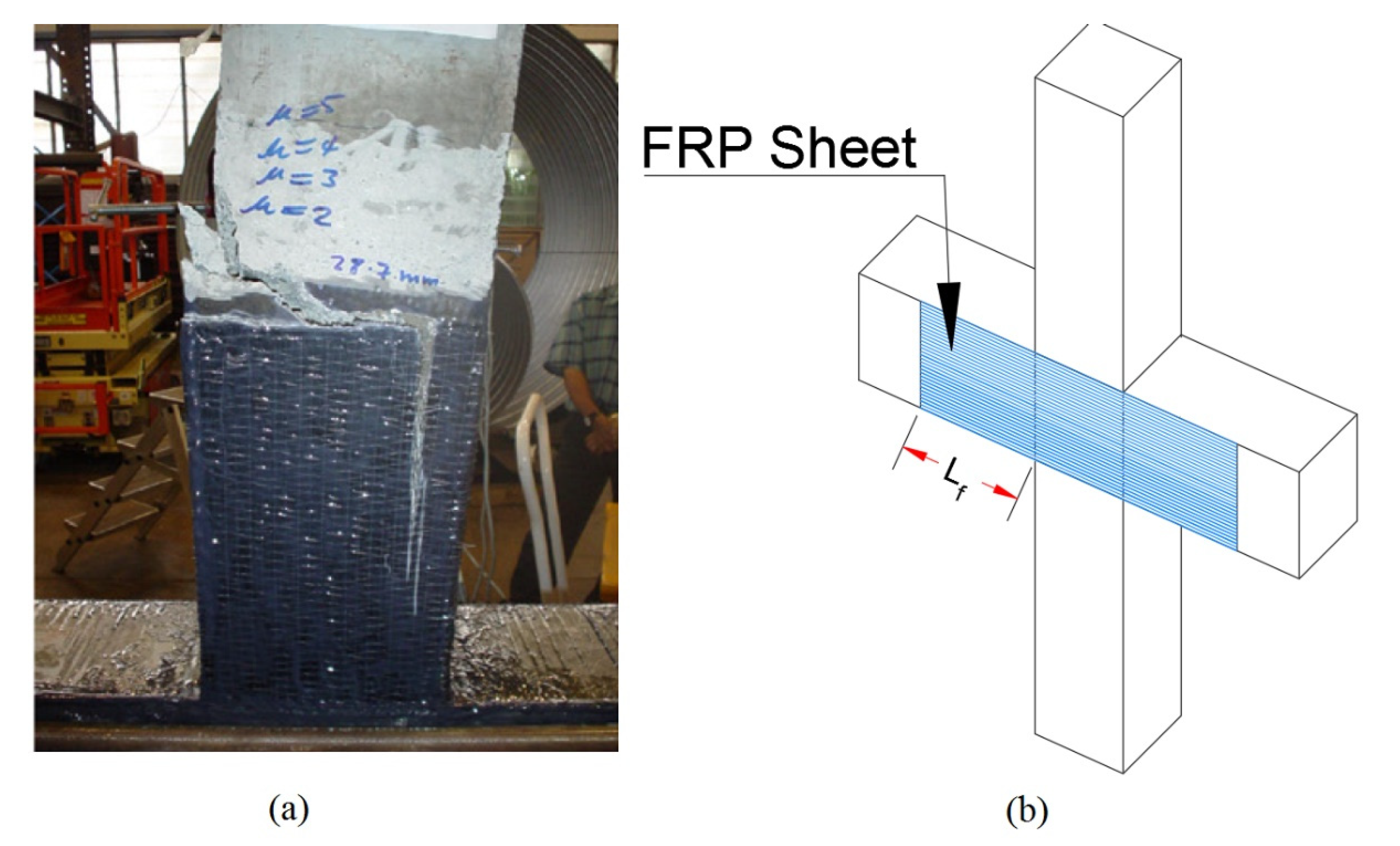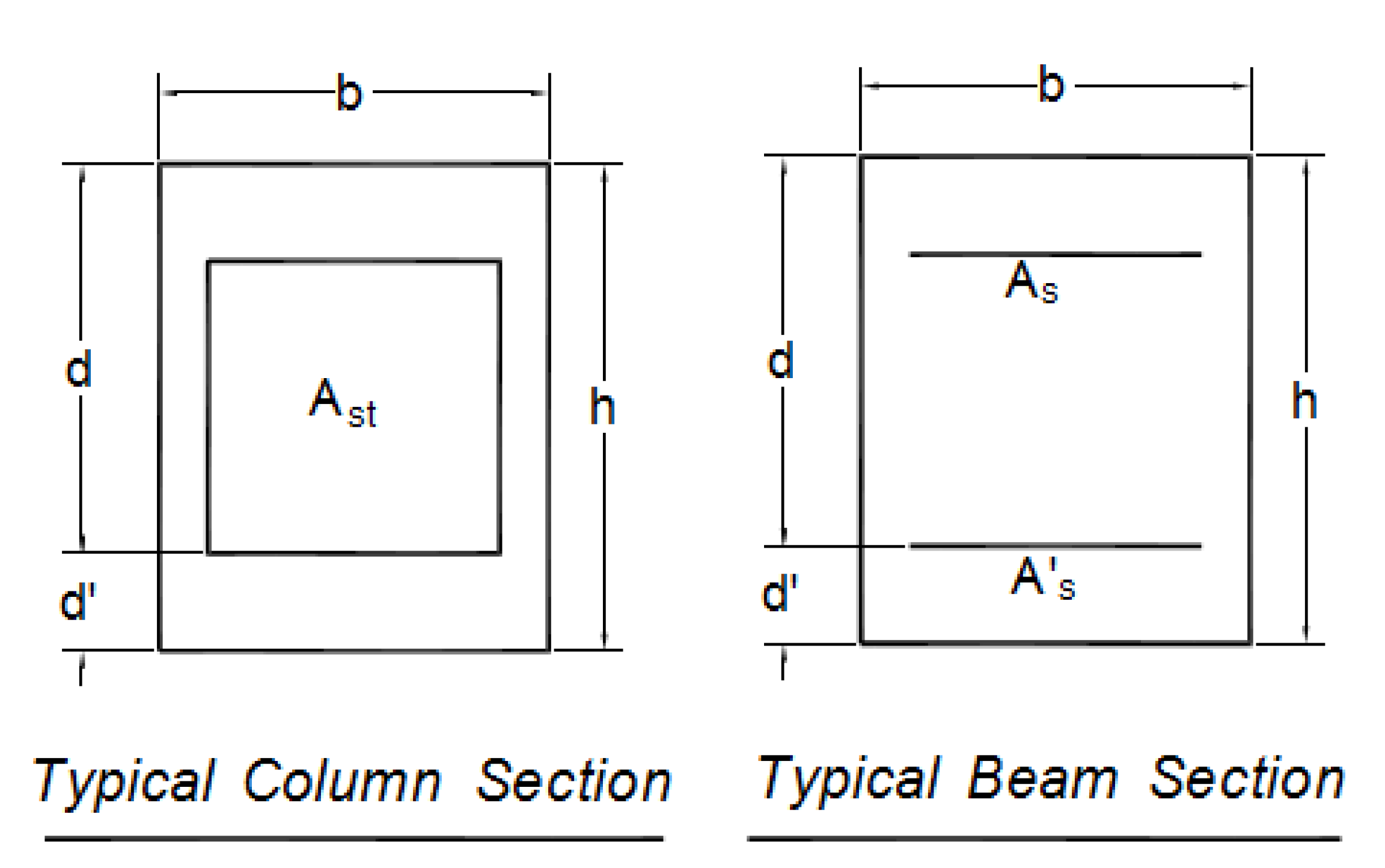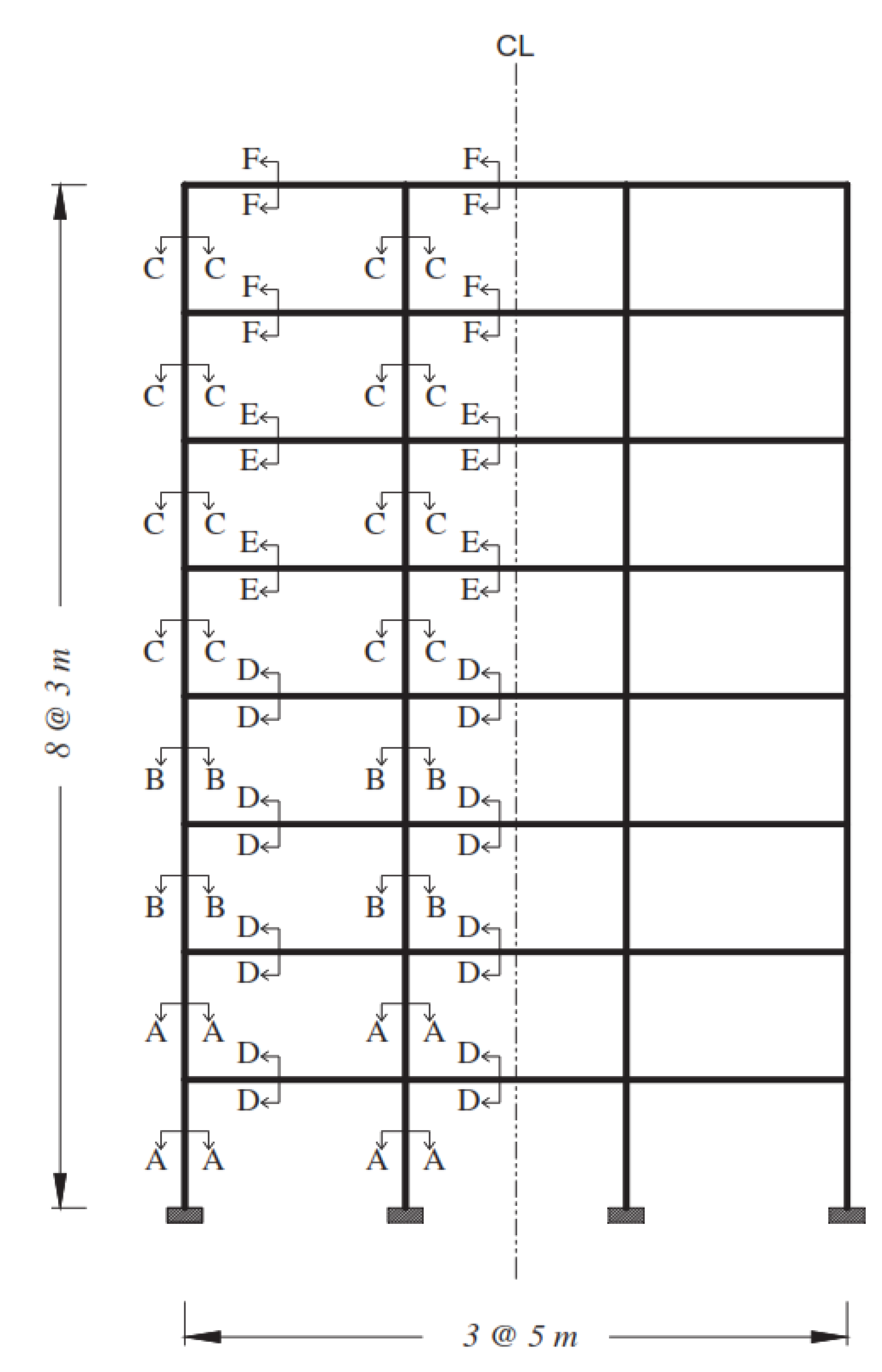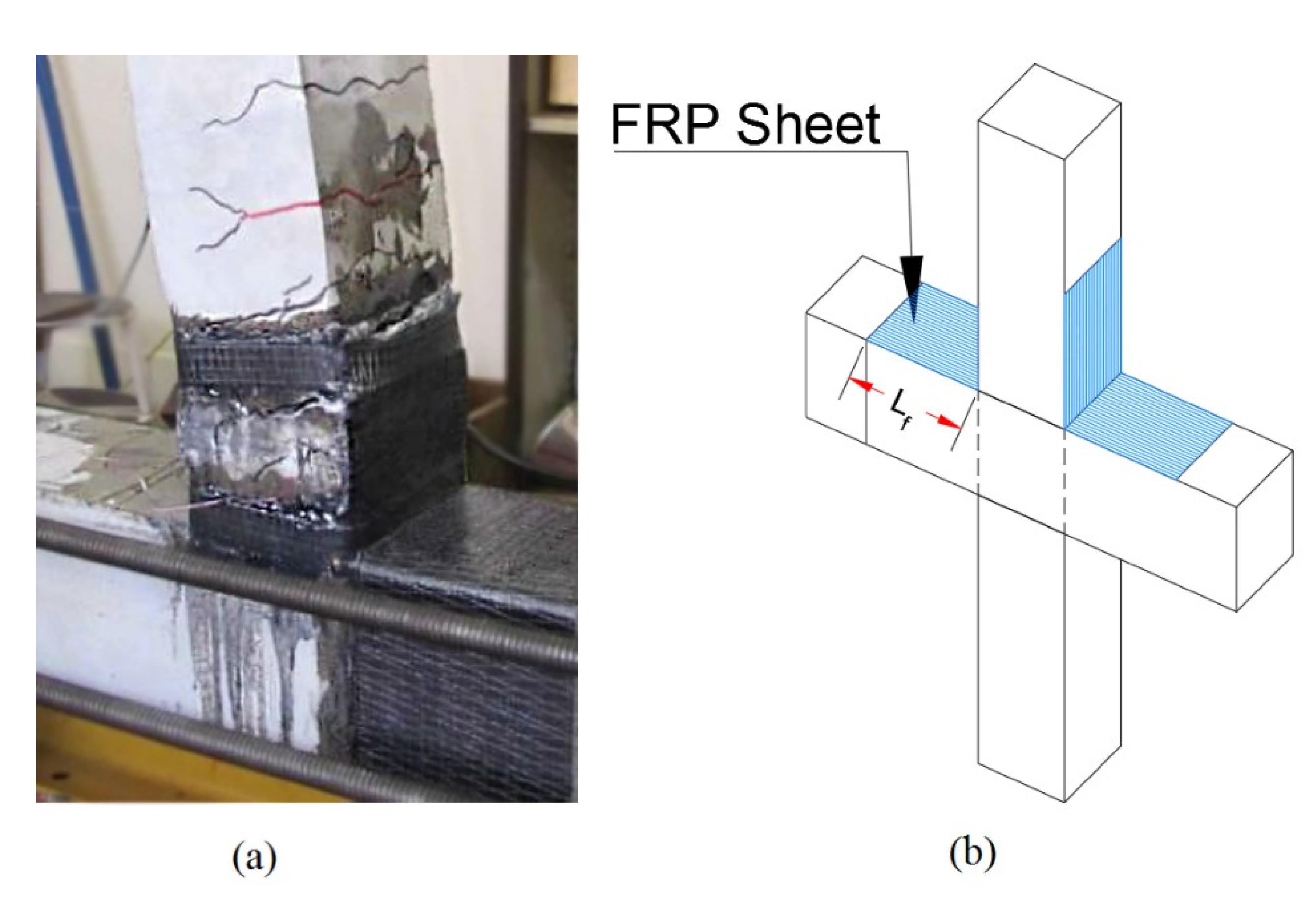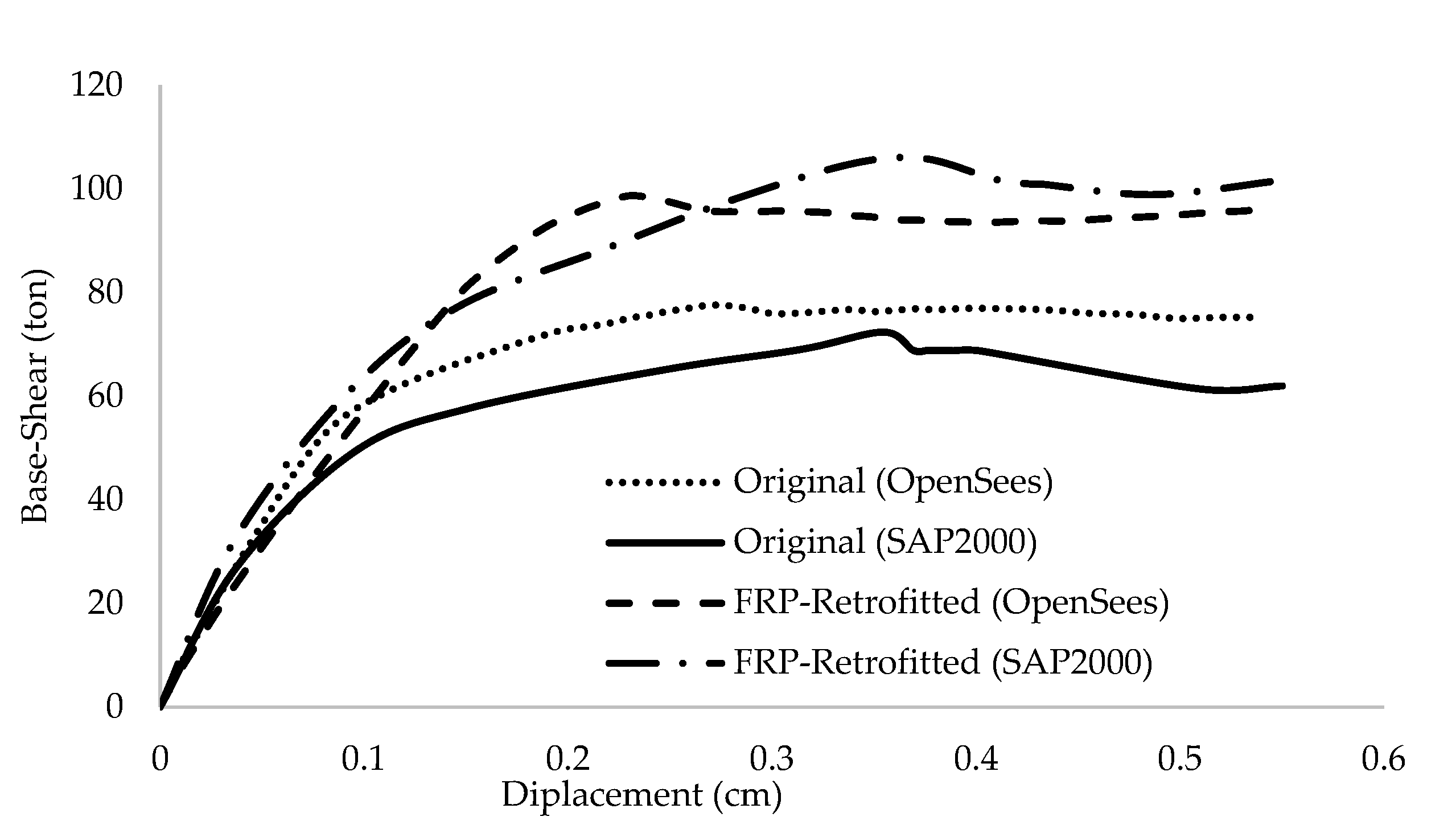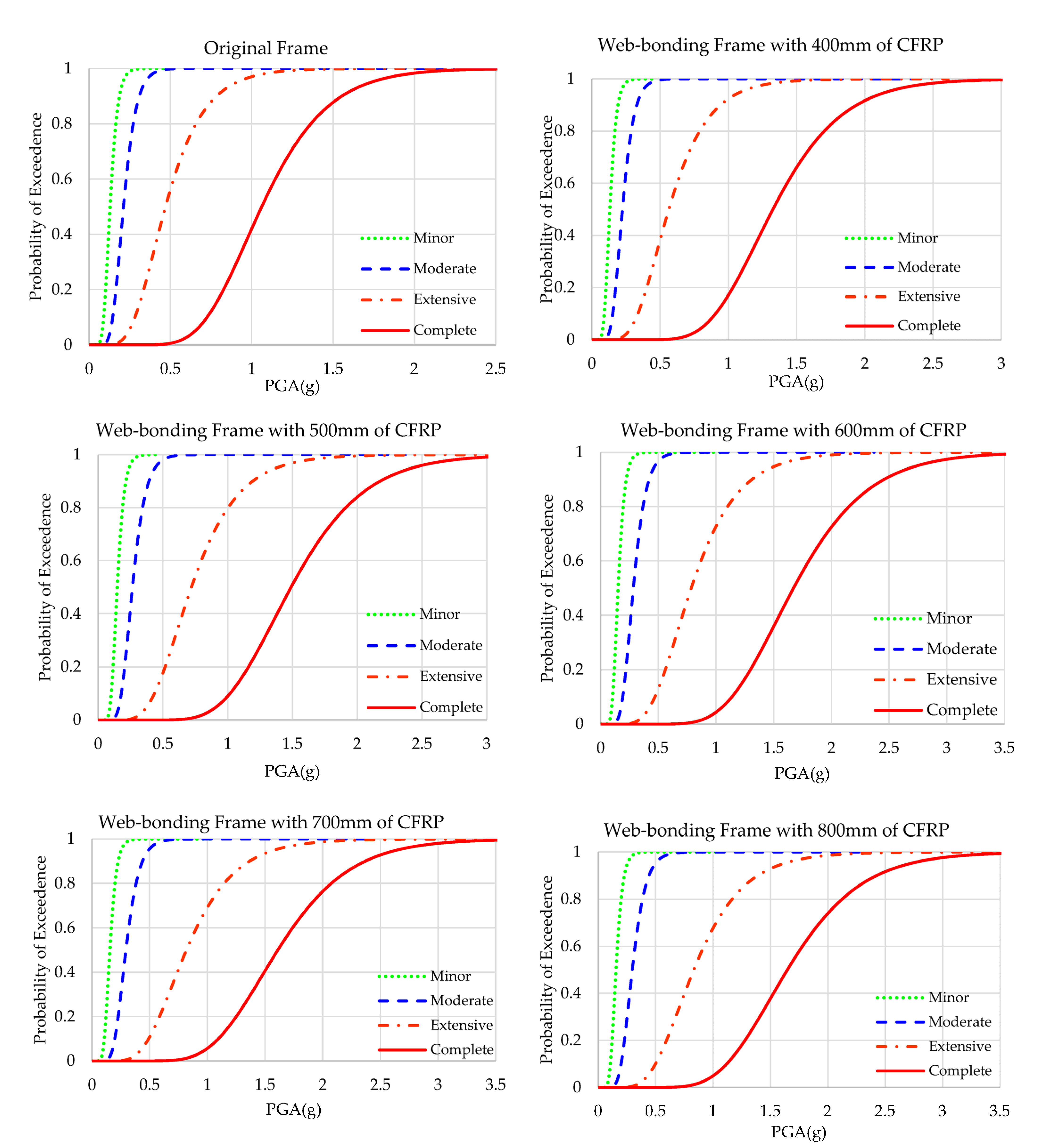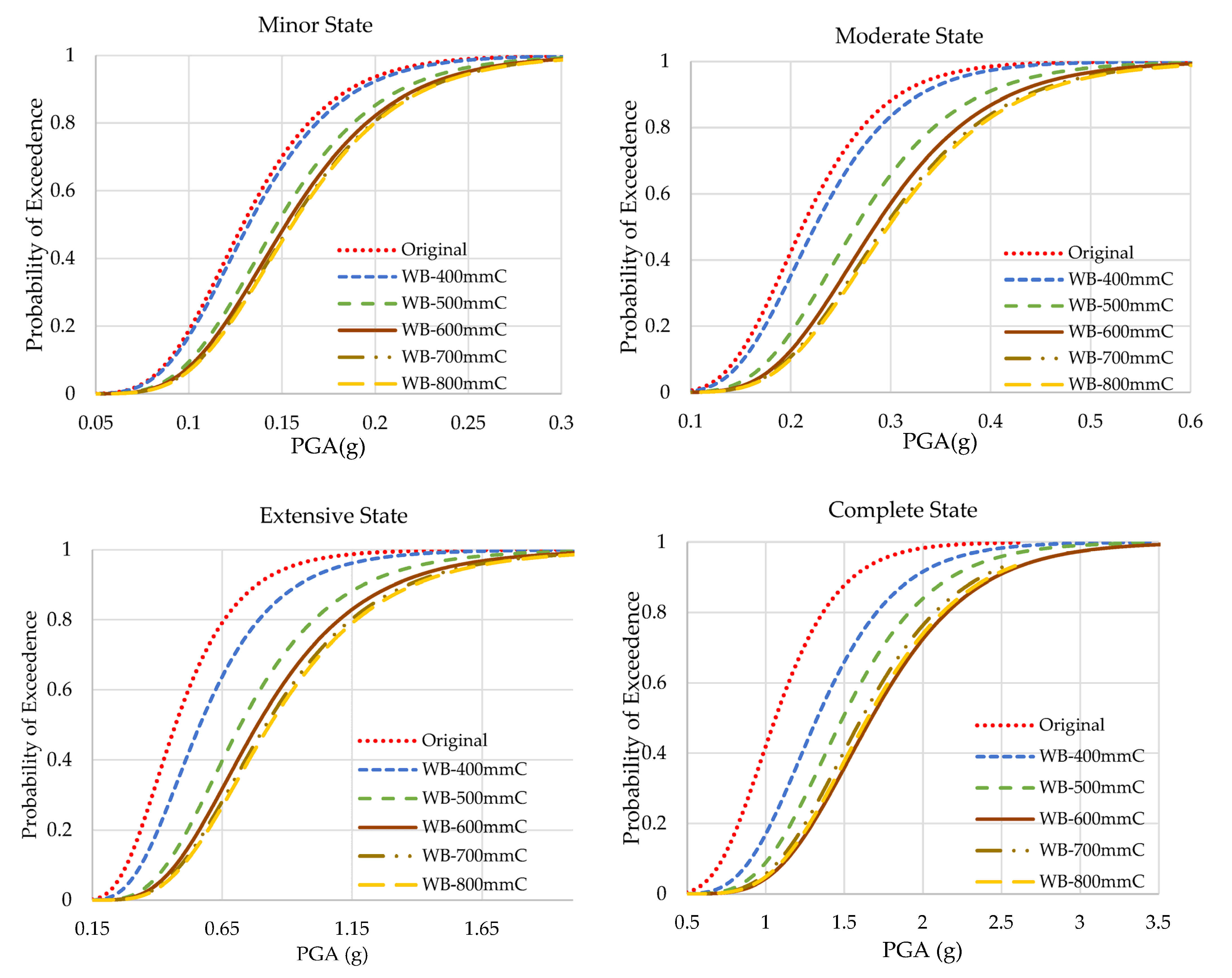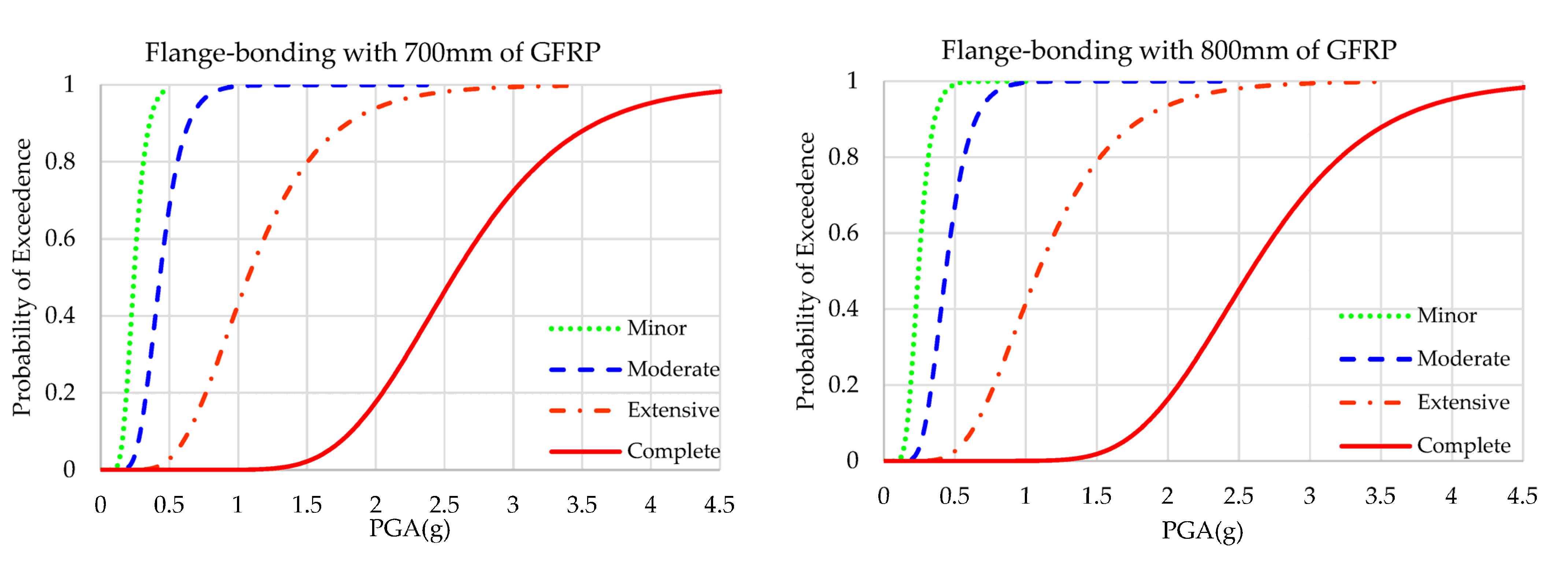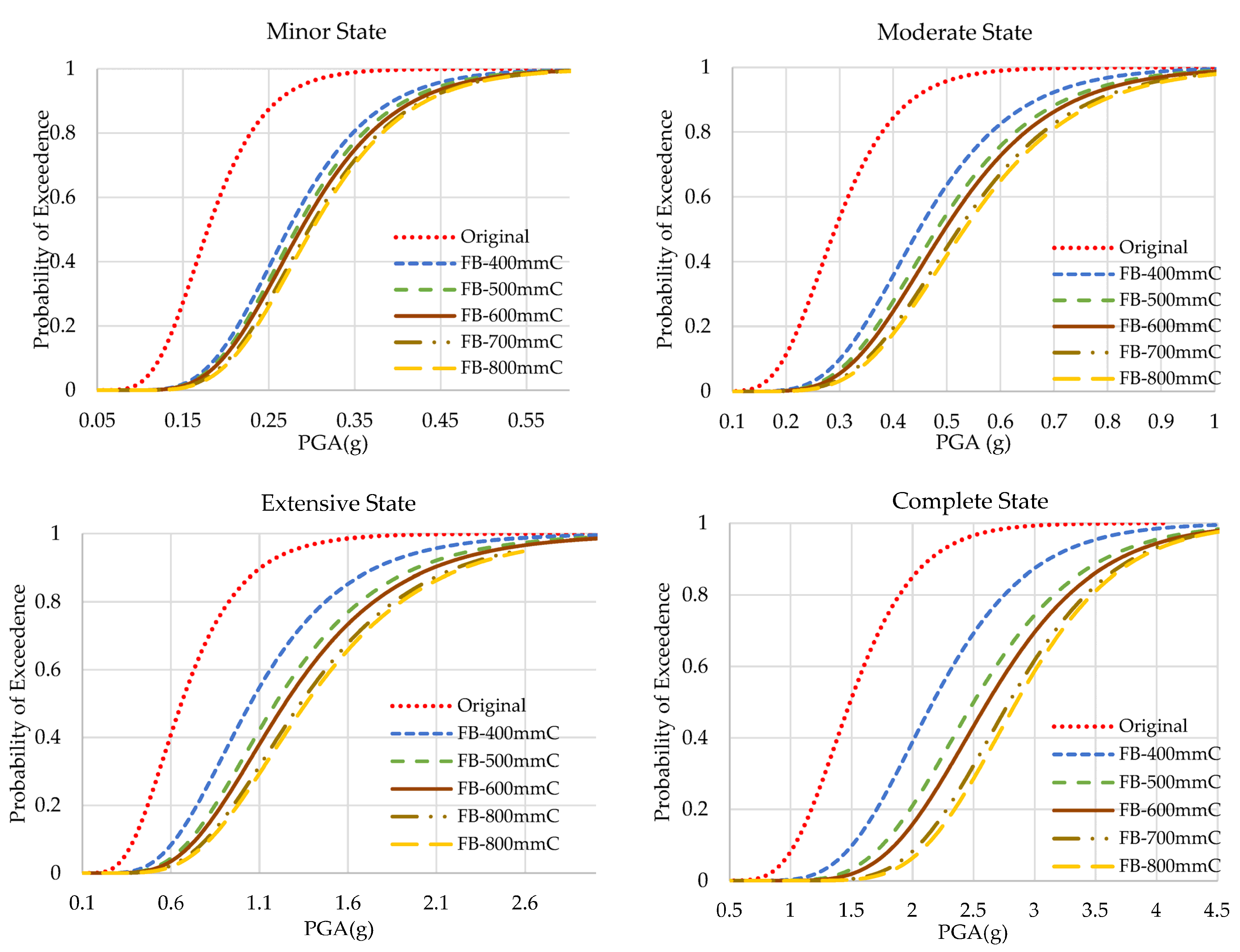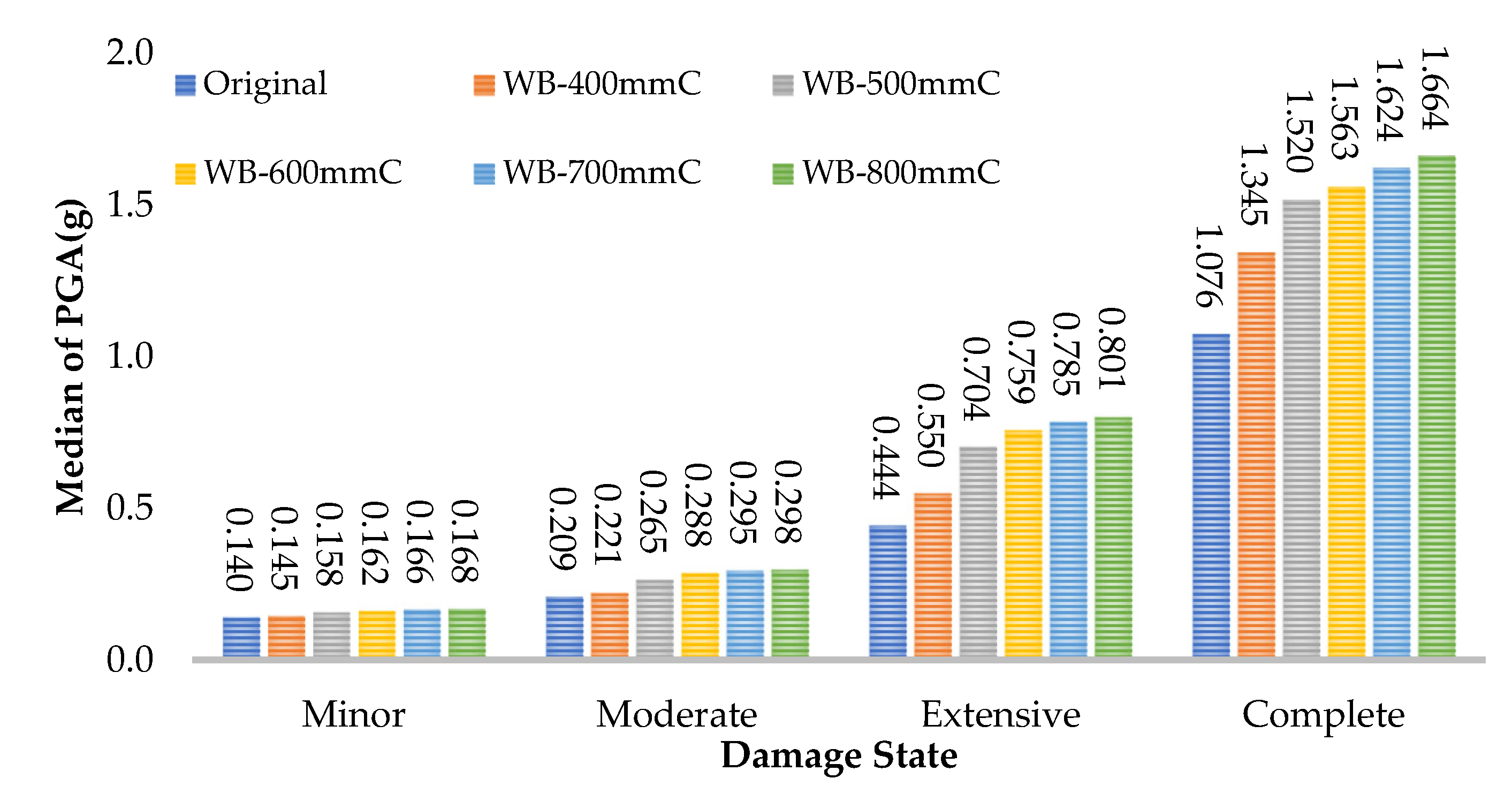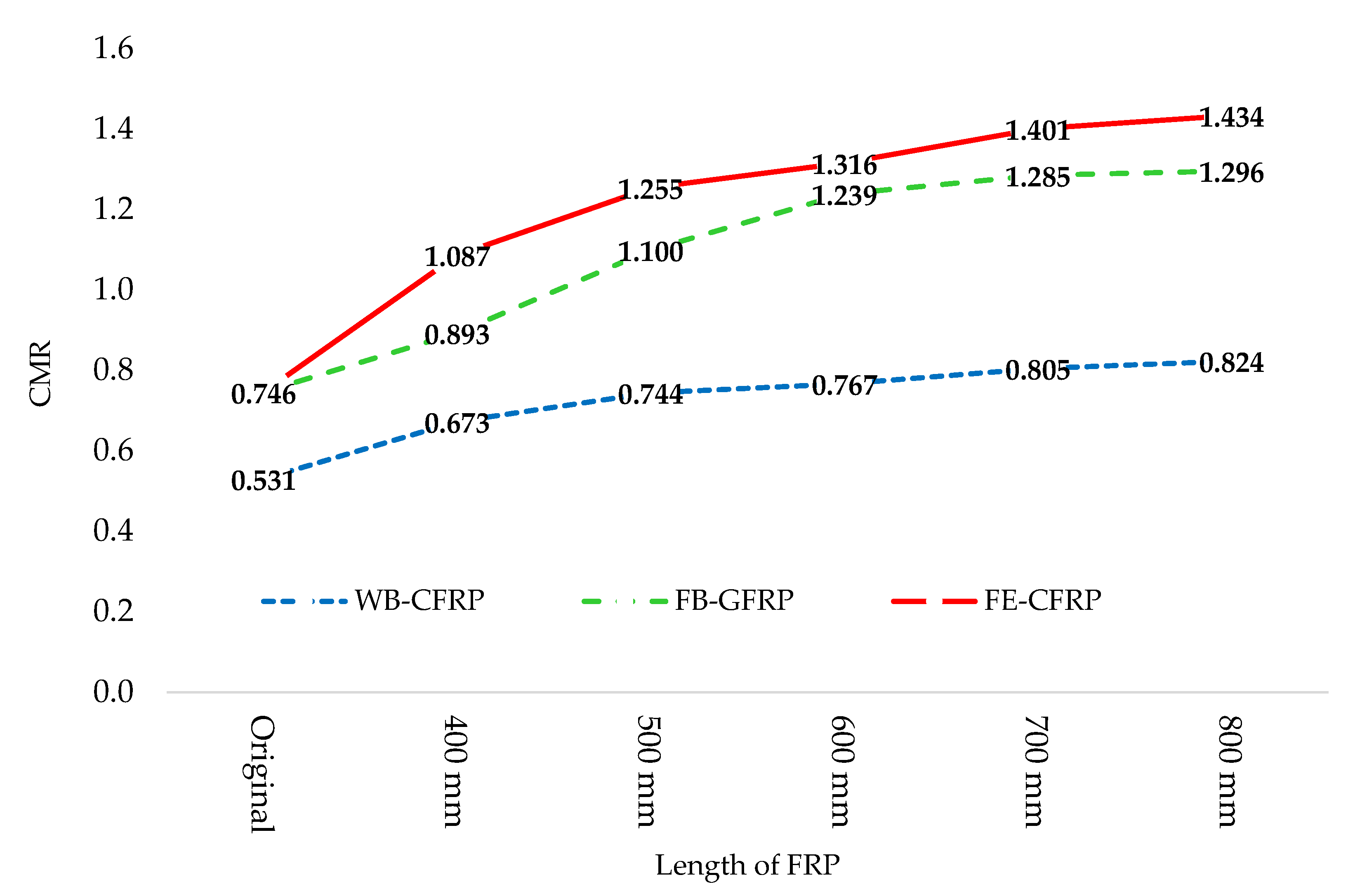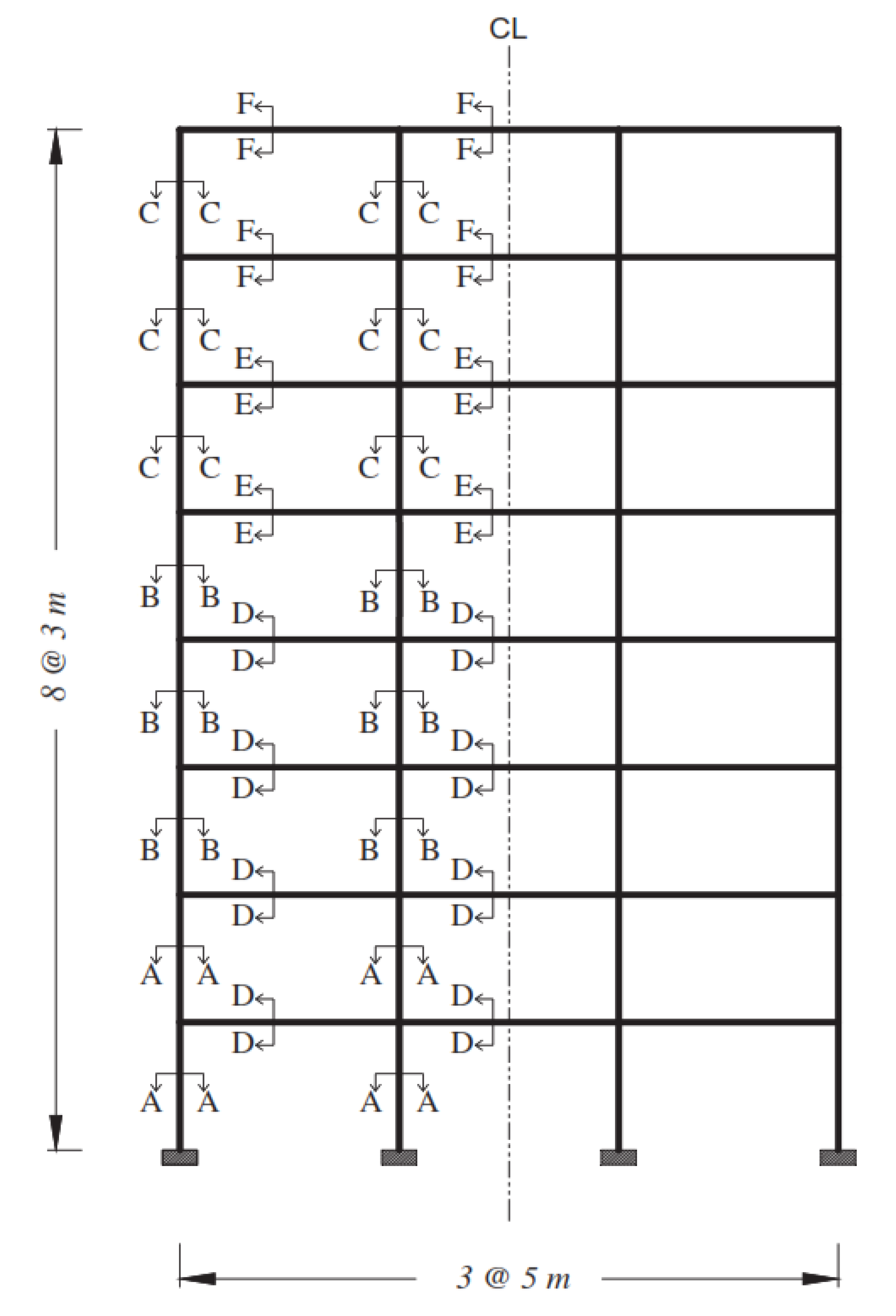1. Introduction
The enhancement of the seismic behaviour of existing RC structures through applying FRP sheets is a popular method in which a composite concrete composite section is produced. In many cases, rehabilitation of some buildings which have been designed for gravity loads and are based on older seismic design codes is necessary. The main reasons for the popularity of the mechanical properties of FRP materials are their lightweight nature, corrosion resistance, strength, stiffness, and applicability to concrete surfaces. CFRP and GFRP have varied benefits and key applications as a result of their disparate composition, performance, and cost. For example, FRPs based on CFRP have a significantly higher strength, excellent fatigue resistance, corrosion resistance and creep resistance, and are also lighter due to their lower density. However, a significant disadvantage of carbon fiber is its high cost and limited elongation at break. Alternatively, GFRP is cheaper and has increased elongation, which is a reason that GFRP is often used, although it performs worse than CFRP, and also suffers from poor corrosion resistance [
1,
2].
FRP materials can be used on beams, columns, connections, and shear walls, which leads to improved lateral load carrying capacity and reduced drift and/or increased ductility [
3]. Nowadays, various methods of evaluating the seismic vulnerability of structures have been developed by researchers [
4]. Fragility curve analysis has been widely used as a probabilistic indicator of structural safety against earthquakes [
5]. This parameter determines the performance of a structure subjected to earthquake load at different damage states [
6]. A referenced two-dimensional, eight-story, three-bay, RC moment-resisting frame, which was retrofitted by Maheri and Akbari [
7] using a steel-bracing system, was retrofitted at joints with Web-bonded CFRP sheets and the results of nonlinear pushover analysis were compared with those of the original frame and the steel-braced frame. Nonlinear pushover analysis is a well-known method to represent the seismic performance of the structures. In a numerical study, Zou et al. [
8] presented an optimisation technique for the performance-based design of seismic FRP-retrofitted RC building frames. Their numerical studies showed that the seismic resistance of a RC frame designed for gravity loads only can be significantly enhanced over confinement of columns using FRP jacketing. They indicated that FRP confinement increases the strength of columns but has little effect on their stiffness. This is an important advantage in seismic retrofitting, as larger stiffnesses lead to higher seismic forces.
Di Ludovico et al. [
9] carried out pushover analysis of the FRP-retrofitted frame tested under bi-directional seismic loading and validated the results with experimental data, confirming the effectiveness of the nonlinear pushover analysis. Niroomandi et al. [
3] studied the effects of Web-bonded FRP-retrofitting of the joints on improving the structural ductility of ordinary RC frames. The retrofitted joints’ stiffness in the form of the moment-rotation relation was first determined by a detailed finite element (FE) modelling of the composite joints and the results were then utilised to carry out nonlinear pushover analysis of the full frame to evaluate its force–displacement capacity curve. The capacity curve was then utilised to evaluate the seismic performance parameters of the frame. Niroomandi et al. [
3] reported that retrofitting with 500 mm FRP sheets can enhance the seismic performance level and the seismic behaviour factor (R) of ordinary RC frames. Obaidat et al. [
10] investigated the behaviour of repaired RC beam-column joints using CFRP plates with a variety of retrofitting schemes. Their results showed that all repaired joints improved the strength of the original joints and even enhanced their strength capacity. Pohoryles et al. [
11], in a state-of-the-art review, revealed several promising features of FRP-strengthening schemes for beam-column joints. They highlighted the important impact of realistic size, loading, and geometry of the testing specimens on the effectiveness of FRP retrofitting. It was shown that, on average, the effectiveness of repairing pre-damaged joints was similar to that of retrofitting specimens without damage.
Various methods, such as fragility curve analysis, have been developed by researchers for evaluating the seismic vulnerability of structures [
2]. Abdelnaby [
12] evaluated the seismic fragility relationship of an RC frame subjected to mainshock–aftershock sequences. Their results showed that the impact of multiple earthquakes can increase the vulnerability of RC buildings significantly. Structures with irregularity in the plan were also studied by Moon et al. [
4]. They applied a different method to derive the fragility curve of a three-dimensional model. Moreover, the seismic collapse fragility analysis of RC frames with shear walls was studied by Dabaghi et al. [
13]. They performed IDA analysis based on FEMA P695 for far-field records. Xian et al. [
14] evaluated the seismic collapse safety and retrofitting low-ductility of RC frames. These researchers compared two retrofitting schemes, including steel-brace retrofitting and increasing the column section. Steel-brace retrofitting showed an increased improvement in seismic response to earthquakes. Heshmati et al. [
15] studied the effect of far-field and near-field earthquake records on the seismic design of IMRF and SMRF structures according to FEMA P695 methodology. They showed that the response modification factors introduced in seismic the design code for IMRF and SMRF under far-field records met the requirement criteria of FEMA P695. However, in the near-field earthquakes, only SMRF had an acceptable behaviour.
Omranian et al. [
16] studied the seismic damage of an RC-skewed bridge subjected to ground motions using fragility curves in the original form and after being retrofitted with FRP. Their results showed that the strengthening method enhanced the fragility of the bridge. Naseri et al. [
17] investigated an analytical method for the improvement of the fragility curves of a strengthening RC box-girder bridge. They confirmed that steel jackets and FRP sheets reduced the fragility vulnerability of the bridge. Shafaeu and Naderpour [
18] investigated the seismic fragility of an FRP-retrofitted ordinary RC frame under mainshock–aftershock earthquakes. Their results showed that although FRP improves that fragility function of the frame, the reduction capacity due to the earthquake records is independent of the strength and ductility of the structure. Devi et al. [
19] compared the fragility curves obtained from a RC structure before and after strengthening by FRP. Their retrofitting strategy increased the capacity of the RC frame. Zhang et al. [
20] developed a fragility analysis for performance-based blast design of FRP-retrofitted RC columns. They compared the results of both the original and retrofitted frames and provided a method to predict the failure probabilities of RC columns under blast loads.
In the current study, the effect of different lengths of FRP sheets applied to the joints on the fragility capacity of an RC frame was investigated. The effective length is an important parameter on the fragility behaviour of RC frames, which has received less prior investigation. Overall, various studies show that FRP materials can enhance the seismic performance of buildings. However, different patterns and configurations of FRP materials have different impacts on the behaviour of the frames. Fragility performance is one of the factors that has not been evaluated as much as is needed. Therefore, this study examined the impact of various configuration of FRP at the joints in terms of improving the fragility function of RC frames.
Accordingly, the main objective of the current study was to investigate the effects of strengthening the joints by different lengths of FRP sheets ranging from 400 mm to 800 mm on the seismic performance parameters of ordinary RC frames and the fragility capacity of the retrofitted frames. The retrofit schemes that were considered are those involving CFRP web-bonding and flange-bonding of the frame joints. The web and flange-bonding of the considered beam are similar to the scheme used previously by a number of investigators, including those reported in [
21,
22,
23,
24,
25,
26,
27]. The variation of the median of PGA on each damage state as well as the collapse margin ratio (CMR) in the original and retrofitted frames were also studied.
4. Fragility Analysis
The selected frames were analysed by far-field records based on FEMA P695 [
41] to determine the collapse capacity and the collapse-margin ratio (CMR). In the IDA analysis, a series of nonlinear dynamic analyses were performed for each seismic record to predict the complete response range. The recommended number of records for deriving fragility curves is 10 to 20 [
42]. Therefore, in this study, 22 individual far-field records were used in FEMA P695 in accordance with
Table 5. The IDA analysis was carried out from 0.1 g to 4 g in 0.1 g increments. Accordingly, 880 IDA analyses were performed for each frame (more than 12,000 analyses for all frames). The maximum drift of each frame was obtained from IDA analyses to produce the fragility curves.
Using MATLAB, the fragility curve for all frames for slight, moderate, extensive, and the complete structural damage states were extracted from the outcome of the IDA analyses. The probability of exceeding the above-mentioned states was modeled as a cumulative lognormal distribution as [
43]:
where:
P is the probability of exceeding a damage state (
D) based on the maximum story drift,
is the standard normal cumulative distribution function,
is the standard deviation of the natural logarithm of spectral displacement of damage state, obtained from Equation (2),
is the median value of spectral displacement at which the frame reaches the threshold of the damage state presented in
Table 6, and
, is the spectral displacement which can be obtained Equation (3) [
42,
44].
where:
a and
b are regression coefficients, obtained from logarithm regression analysis of maximum drift in different PGAs. As the number of stories of all frames is eight, based on HAZUS-MH MR-5 [
43], these structures are considered as high-rise types; thus, the structural fragility curve parameters (for moderate code) are in accordance with
Table 6.
4.1. Fragility Curves of Web-Bonding Frame
The results of the fragility analyses of original and web-bonded frames with 400 to 800 mm of CFRP sheets are presented in
Figure 9. To study the effect of the length of FRP sheets in the web-bonding frames, the fragility curve of each state was compared and shown
Figure 10. In all states, the fragility function of the original frame improved. Applying 400 mm of CFRP on the web of joints of the frame caused a slight enhancement. However, changing the length of CFRP sheets to 500 mm led to a significant improvement. Using longer FRP sheets increased the seismic capacity at a low slope rate.
To obtain a better understanding regarding the enhancement of the fragility capacity of all the web-bonded frames, the PGAs of the probability of 50% and 100% of occurrence of each state are compared in
Table 7. The probability of reaching complete collapse in the original frame is 2.458 g of PGA. However, applying 400, 500, 600, 700, and 800 mm of CFRP on the web of joints enhanced this parameter to 2.831, 3.188, 3.307, and 3.489 g, respectively. Therefore, it can be concluded that the effectiveness of CFRP sheets on the web of the joints is higher at the critical states.
4.2. Fragility Curves of Flange-Bonding Frame
The results of the fragility analyses of the original and flange-bonded frames with 400 to 800 mm of GFRP and CFRP sheets are presented in
Figure 11 and
Figure 12, respectively.
Figure 13 and
Figure 14 compare the results of fragility analyses in each individual state. The behaviour of frames was similar to the web-bonding one. However, the rate of enhancement was greater. The improvement of the seismic response and fragility capacity occurred in flange-bonding frames. The impact of CFRP materials on the fragility curves of frames was greater when compared with GFRP. Unlike web-bonding frames, a significant improvement was observed even in sheets with 400 mm. The same growth occurred in 500 mm FRP. However, similar to the web-bonding frames, the longer FRP sheets showed a minor enhancement. The impact of applying FRP in the higher seismic levels was greater compared with the minor and moderate states. For the GFRP and CFRP, flange-bonded frame summaries of the fragility curves are presented in
Table 8 and
Table 9. The required PGA values to reach 50% and 100% of each state for all frames were compared. In the original frames, the probability of 100% complete collapse occurred with 3.069 g of PGA. However, applying 400, 500, 600, 700, and 800 mm of GFRP on the flange of the joints improved this parameter to 3.556, 4.159, and more than 4.500 g of PGA. The enhancement in the FB-CFRP frames was more noticeable, whereas, using 400 mm of CFRP improved the required PGA to 4.350 g and using 500 mm and, moreover, enhanced this parameter up to 4.500 g. The reason for a better enhancement of CFRP materials compared with the GFRP material is its higher modulus of elasticity and tensile strength.
6. The Effect of FRP Retrofitting on CMR
The collapse margin ratio (CMR) is a comprehensive tool that reflects the complete seismic capacity of buildings [
15]. This parameter, based on the FEM P695 report [
41], is defined as the ratio of the median intensity of a collapse level ground motion (complete damage state),
to the spectral acceleration with the MCE and collapse level earthquake,
. CMRs are calculated using Equation (4):
was obtained from the fragility curve and IDA analysis and
was determined based on Iranian seismic code 2800 [
29]. The CMRs of all frames in the complete damage state are presented in
Figure 18. Using FRP effectively improved this parameter. The rate of improvement in FRP with 400 and 500 mm lengths in all frames experienced a significant increase. Applying longer FRP sheets led to a moderate improvement. The flange-bonded frames showed better performance in comparison with the web-bonding frames. Overall, CMR was improved by 55%, 74%, and 92% in CFRP web-bonding, GFRP, and CFRP flange-bonding frames, respectively.
7. The Relationship between Plastic Hinging and Fragility
To show the impacts of the plastic hinges on the fragility capacity of frames retrofitted with different lengths from 400 mm to 800 mm, the plastic hinge distributions and their performance levels for the original and FRP retrofitted frames at the target displacement point are given in
Table 10. The performance levels of the joints were obtained graphically from force–displacement capacity curves and the results are shown in
Table 10. The letters B to E and notations IO (immediate occupancy), LS (life safety), and CP (collapse prevention) represent these performance states.
In terms of plastic hinging, although the number remained the same, the level of plastic hinging decreased. The state of plastic formation improved from E to D for the frame with 400 mm FRP. This improvement led to improvement in the fragility capacity in extensive and complete damage states, while, in the minor and moderate states the improvement was minimal. Using 500 mm of FRP reduced the number of plastic hinges in D and LS states noticeably, which resulted in a considerable improvement in all damage states from minor to complete. However, the number of plastic hinges in frames in D and LS states decreased by a small rate by applying longer FRP sheets from 600 to 800 mm. This shift has a slight impact on the fragility response of the frame and a minimal improvement was observed.
The number of plastic hinges in the flange-bonding frame with 400 mm of GFRP in beams as well as columns decreased in severe states in comparison with the original frame. Applying longer GFRP sheets resulted in eliminating plastic hinges in beams and columns with level E for 500 mm of GFRP. This shift led to the improvement of the fragility response in all states compared with the original and 400 mm frames. The number of plastic hinges in frames with 600 to 800 mm of GFRP in critical states remained the same; thus, the fragility capacity of these frames showed minimal improvement. Similar behaviour was observed in flange-bonding CFRP-retrofitted frames. However, in the 400 mm frame, controlling the plastic hinge has been more successful, and the number of plastic hinges at the LS level decreased at a higher rate in comparison with the similar frame with GFRP; thus, the improvement of fragility capacity at 400 mm noticeably happens for all damage states. Moreover, using longer CFRP sheets on the flange of connections has a small impact on the number of plastic hinges in severe states with minimal improvements in the level of beams and columns led to a small enhancement of the fragility curve in frames with 500 to 800 mm CFRP.
8. Controlling Debonding Effect
Previous studies have shown that debonding failure can occur in FRP sheets before the loads reach the expected values, which leads to unsatisfactory enhancement effects and decreases the load-carrying capacity of the rehabilitated elements [
45]. Therefore, it is vital to control the debonding failure of FRP-retrofitted joints particularly at the end of the sheets. In this study, the maximum strain that occurred in FRP sheets obtained from OpenSees was compared to the maximum values recommended in ACI 440.2-2017 [
46] and the proposed equations by Chen and Teng [
47] and Teng et al. [
48]. The effective FRP strain is limited by the following:
where,
εfd is the maximum strain recommended and less than that which the FRP sheet is prevented from debonding,
f′c is the 28 day concrete compressive strength,
n is the number of sheet layers, and
Ef and
tf are the elastic modulus and the thickness of the FRP sheet, respectively.
Table 11 and
Table 12 indicates the maximum effective FRP strains that occurred at the end of the sheets obtained from the models in OpenSees for web-bonded frames and Flange-bonded frames as well as the amounts derived from Equation (5) where these amounts are compared with the limiting values allowed by ACI 440.2-2017. These tables confirm that the probability of occurrence of local debonding failure at the end of the sheets due to shear or normal stress concentrations is highly unlikely.

